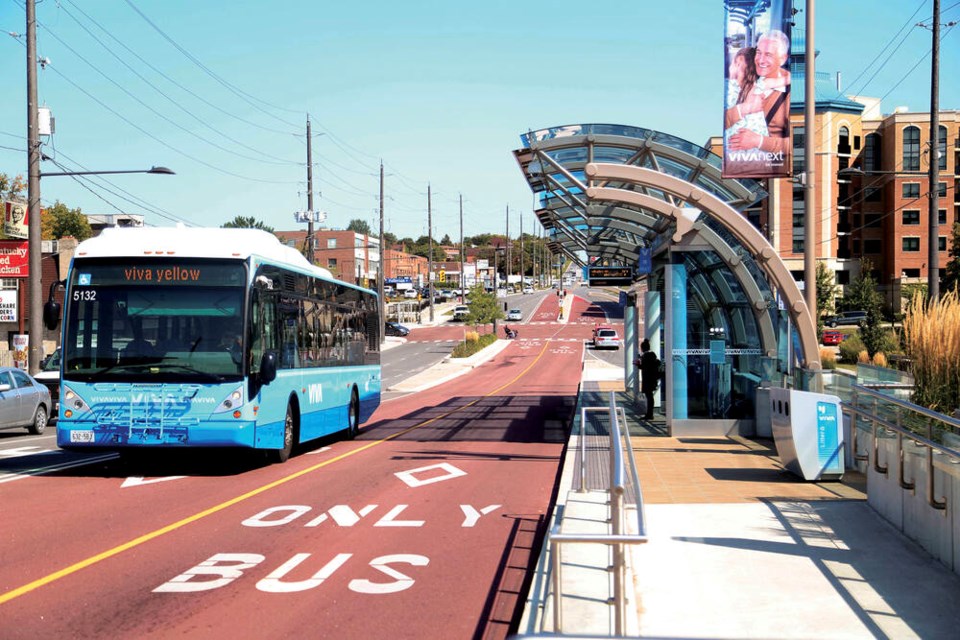A North Shore-to-Burnaby bus rapid transit route will be among the first up and running when TransLink starts rolling out improvements in Metro Vancouver’s transit system – but likely not until 2027 at the earliest.
TransLink announced Thursday that the Park Royal-to-Metrotown route, with connections to the SkyTrain’s Evergreen and Millennium lines, would be at the front of the line, along with King George Boulevard and Langley Township-to-Maple Ridge routes.
TransLink CEO Kevin Quinn said bus rapid transit will be a “game changer” for Metro Vancouver – faster and more convenient and reliable than the existing RapidBus lines.
“Bus rapid transit is the best possible bus service – rapid transit with traffic-separated bus lanes, high frequencies and rail-like stations for boarding,” he said. “BRT is the backbone of so many world class transit systems around the world. We want to be next on that list.”
Speaking for the North Shore’s three councils, City of North Vancouver Mayor Linda Buchanan welcomed the North Shore route being made a priority.
“Everyone knows that congestion has reached a tipping point. People are spending too much time commuting and not enough time living,” she said. “Our only way out of this crisis is to deliver a new option that allows people to move efficiently.”
The actual route alignment, stops and station designs still are not developed. TransLink will do public engagement on those in the spring and summer of 2024, Quinn said.
If TransLink can secure funding for the projects from all three levels of government, the agency will go through a procurement process in 2025 aiming to have the bus rapid transit system rolling out in 2027, Quinn said.
The Mayors’ Council does, however, have an interim plan that will see transit improvement on the North Shore even sooner by extending the existing R2 RapidBus from Phibbs Exchange to Metrotown, likely replacing the 222 express bus.
There is no timeline for when the R2 extension will come online but before it can happen, TransLink will have to acquire more buses and make bus priority infrastructure improvements along the route to ensure the RapidBus doesn’t fall behind schedule in general vehicle traffic.
Buchanan expressed confidence that the extension of the R2 would be an impactful measure in the meantime.
“I think people are wanting fast, reliable service and we want to make sure that we deliver that. There’s not an alternative competitive route other than the car,” she said. “Providing that immediate extension while we simultaneously plan for the entire corridor of rapid transit gives people what they’ve been asking for.”
The proposed BRT timeline is far too tight to build any kind of a new rapid transit crossing over Burrard Inlet, Quinn acknowledged, so work is happening simultaneously on a longer-term rapid transit solution for the North Shore, he said.
Neither the Bus Rapid Transit route nor the extension of the R2 will involve re-purposing any of the existing lanes on the Ironworkers Memorial Second Narrows Crossing for buses only, Quinn said.
District of North Vancouver Mayor Mike Little acknowledged that traffic weary residents and commuters might like to see BRT arrive sooner than 2027, but he said bus service on every route will improve as the new infrastructure comes online in phases.
“We don’t have to wait till it’s all completed to get some of the benefits,” he said. “We obviously want to see it progress as quickly as we reasonably can. We’re all committed to talking to our counterparts in Victoria and Ottawa to try to get their supports moved up and, hopefully, the construction moved forward.”
There was stiff competition among the municipalities to get to the top of the list of nine BRT lines included in the Mayors’ Council's 10-year plan, said chair and Port Coquitlam Mayor Brad West, but the routes were agreed to by the council members based on their ability to maximize people’s access to rapid transit, along with ridership potential and population growth.
TransLink estimates there are already 120,000 people and 90,000 jobs within walking distance of the North Shore BRT route.




